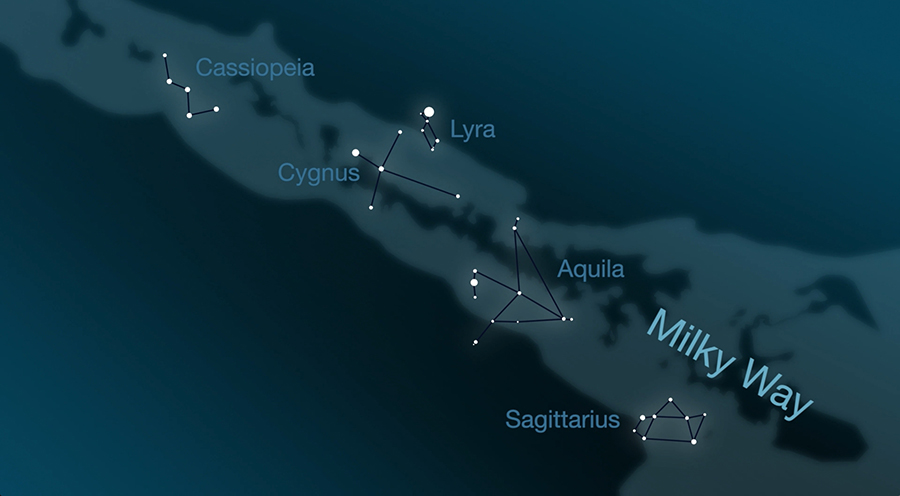
Eclipse 2024 Pictures
We have started uploading picture of the April 8th 2024 Eclipse come check them out! Eclipse 2024 Pictures (click Here)
Current Astronomy Jan Feb 2024
The new edition of Current Astronomy is out. check it out, under the Newsletter menu tab
First Quarter Moon Day canceled for August 21, 2023.
**The First Quarter Moon Day telescope viewing for August 21 is cancelled.** We hoped to power through and view the sky this evening but the heat and humidity and poor air quality have made conditions …
Monthly Telescope Viewing Now Offered
The River Bend Astronomy Club received permission from the Glik Company to host MONTHLY telescope viewing at the Highland (Illinois) NorthTown shopping center! We will set up between the two NorthTown signs and along Rt. …
Aug 25
A Trip Through the Milky Way
By Jane Houston Jones and Jessica Stoller-Conrad

Caption: This illustration shows how the summer constellations trace a path across the Milky Way. To get the best views, head out to the darkest sky you can find. Credit: NASA/JPL-Caltech
Feeling like you missed out on planning a last vacation of summer? Don’t worry—you can still take a late summertime road trip along the Milky Way!
The waning days of summer are upon us, and that means the Sun is setting earlier now. These earlier sunsets reveal a starry sky bisected by the Milky Way. Want to see this view of our home galaxy? Head out to your favorite dark sky getaway or to the darkest city park or urban open space you can find.
While you’re out there waiting for a peek at the Milky Way, you’ll also have a great view of the planets in our solar system. Keep an eye out right after sunset and you can catch a look at Venus. If you have binoculars or a telescope, you’ll see Venus’s phase change dramatically during September—from nearly half phase to a larger, thinner crescent.
Jupiter, Saturn and reddish Mars are next in the sky, as they continue their brilliant appearances this month. To see them, look southwest after sunset. If you’re in a dark sky and you look above and below Saturn, you can’t miss the summer Milky Way spanning the sky from southwest to northeast.
You can also use the summer constellations to help you trace a path across the Milky Way. For example, there’s Sagittarius, where stars and some brighter clumps appear as steam from a teapot. Then there is Aquila, where the Eagle’s bright Star Altair combined with Cygnus’s Deneb and Lyra’s Vega mark what’s called the “summer triangle.” The familiar W-shaped constellation Cassiopeia completes the constellation trail through the summer Milky Way. Binoculars will reveal double stars, clusters and nebulae all along the Milky Way.
Between Sept. 12 and 20, watch the Moon pass from near Venus, above Jupiter, to the left of Saturn and finally above Mars!
This month, both Neptune and brighter Uranus can also be spotted with some help from a telescope. To see them, look in the southeastern sky at 1 a.m. or later. If you stay awake, you can also find Mercury just above Earth’s eastern horizon shortly before sunrise. Use the Moon as a guide on Sept. 7 and 8.
Although there are no major meteor showers in August, cometary dust appears in another late summer sight, the morning zodiacal light. Zodiacal light looks like a cone of soft light in the night sky. It is produced when sunlight is scattered by dust in our solar system. Try looking for it in the east right before sunrise on the moonless mornings of Sept. 8 through Sept 23.
You can catch up on all of NASA’s current—and future—missions at www.nasa.gov

Jul 25
The Best Meteor Shower of the Year

Caption: The Perseid meteor showers appear to radiate from the constellation Perseus. Perseus is visible in the northern sky soon after sunset this time of year. Credit: NASA/JPL-Caltech
By Jane Houston Jones and Jessica Stoller-Conrad
If you’re a fan of meteor showers, August is going to be an exciting month! The Perseid meteor shower is the best of the year, and in 2018, the peak viewing time for the shower is on a dark, moonless night—perfect for spotting meteors.
The best time to look for meteors during this year’s Perseid shower is at the peak, from 4 p.m. EDT on Aug. 12 until 4 a.m. EDT on the Aug. 13. Because the new Moon falls on the peak night, the days before and after the peak will also provide very dark skies for viewing meteors. On the days surrounding the peak, the best time to view the showers is from a few hours after twilight until dawn.
Meteors come from leftover comet particles and bits from broken asteroids. When comets come around the Sun, they leave a dusty trail behind them. Every year Earth passes through these debris trails, which allows the bits to collide with our atmosphere and disintegrate to create fiery and colorful streaks in the sky—called meteors.
The comet that creates the Perseid meteor shower—a comet called Swift-Tuttle—has a very wide trail of cometary dust. It’s so wide that it takes Earth more than three weeks to plow all the way through. Because of this wide trail, the Perseids have a longer peak viewing window than many other meteor showers throughout the year.
In fact, this year you should be able to see some meteors from July 17 to Aug. 24. The rates of meteors will increase during the weeks before Aug. 12 and decrease after Aug. 13. Observers should be able to see between 60 and 70 meteors per hour at the shower’s peak.
The Perseids appear to radiate from the constellation Perseus, which is where we get the name for this shower. Perseus is visible in the northern sky soon after sunset this time of year. Observers in mid-northern latitudes will have the best views.
However, you don’t have to look directly at the constellation Perseus to see meteors. You can look anywhere you want to; 90 degrees left or right of Perseus, or even directly overhead, are all good choices.
While you’re watching the sky for meteors this month, you’ll also see a parade of the planets Venus, Mars, Jupiter and Saturn—and the Milky Way also continues to grace the evening sky. In next month’s article, we’ll take a late summer stroll through the Milky Way. No telescope or binoculars required!
Catch up on all of NASA’s current—and future—missions at www.nasa.gov

Wind: 11mph SSW
Humidity: 50%
Pressure: 29.91"Hg
UV index: 5
66°F
64°F
61°F
59°F
70°F / 54°F
77°F / 64°F
81°F / 68°F
81°F / 63°F

